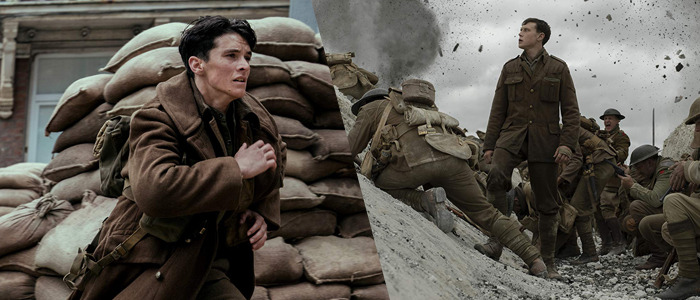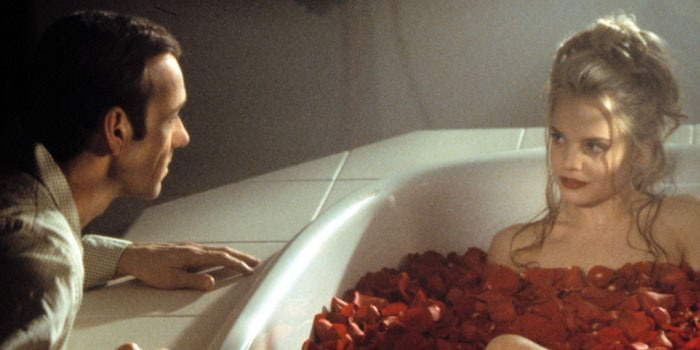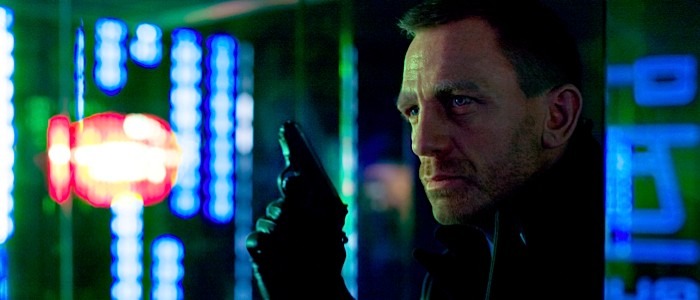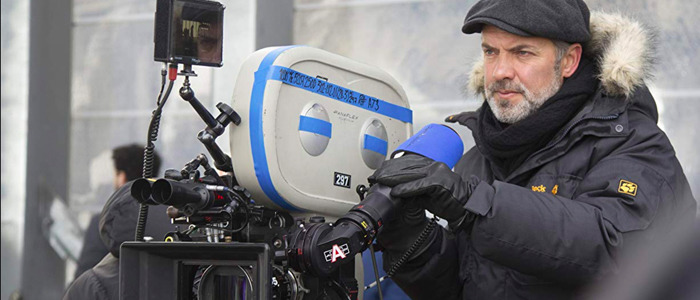Why Does Sam Mendes Keep Making Movies That Feel Indebted To Christopher Nolan?
If imitation is indeed the sincerest form of flattery, then there are a select few living filmmakers whose ears must burn on a regular basis. The frequency of imitation arguably heightens which directors truly are considered among the greatest, or at least the most influential, ever — not many directors would copy someone whose work isn't up to par. One of the most remarkable cases of imitation comes courtesy of a director who, 20 years ago, burst onto the scene with a debut film that felt defiant and daring creatively. When he directed American Beauty, Sam Mendes felt like a fresh new voice in English-language cinema. Yet now, Mendes cannot help but make films that are heavily indebted to Christopher Nolan.
Time Is The Enemy
Mendes' new film, the World War I story 1917, has a gimmick at its core that will be impossible to ignore: the nearly 2-hour film is presented in what appears to be a continuous shot. Just as that gimmick itself is easy enough to clarify, so too is the plot. Two lance corporals on the British side are tasked with crossing enemy lines to stop a morning battle in which the British forces (including the brother of one of the two protagonists) will be massacred by the Germans in a surprise ambush. Of course, the plot was pretty easy to clarify in Christopher Nolan's Dunkirk a couple years ago, as was its own mildly gimmicky storytelling structure. The Best Picture nominee was a cinematic depiction of the evacuation of British forces in Dunkirk during World War II, told from three perspectives: land, air, and sea. Both 1917 and Dunkirk have compressed timelines — the former takes place over a 24-hour period (with roughly each of its two hours meant to unfold in real-time stretches), and the latter has three different timelines to match its perspectives, of a week, a day, and an hour. The tagline for 1917 is "Time is the enemy," matched by how the sound design of Dunkirk was driven by a ticking clock.Both in terms of the marketing campaigns and the films themselves, 1917 cannot help but feel like it's following in the intensely worn footsteps Dunkirk trod a couple years ago. It's not that 1917 is a bad film — Mendes and his cinematographer, the legendary Roger Deakins, have essentially conducted a cinematic experiment quite successfully. That the movie maintains its tension throughout some bloody setpieces is remarkable because the camera is never that still and rarely attempting to capture the full breadth and depth of World War I carnage. Like Dunkirk, 1917 features a number of recognizable British actors, each of whom appears in brief but memorable cameos. (If any of the well-known actors steals a scene, it's Andrew Scott of Sherlock and Fleabag, as an embittered lieutenant.)
So Much Beauty in the World
As easy as it is to look at 1917 and just see a kind of carbon copy of Dunkirk (in spite of the fact that the former film is dedicated to Mendes' grandfather, a lance corporal in World War I whose stories of his time in battle inspired the film), we shouldn't ignore the fact that this isn't the first time Mendes has either deliberately or unintentionally been inspired by Christopher Nolan. But that's not how Mendes' path began when he burst onto the scene as a cinematic wunderkind in 1999. Mendes' career as a director was initially impossible to pigeonhole, both before and after his shift into big-budget filmmaking. His debut feature, American Beauty, was such a massive hit upon its initial release that Mendes was treated with the same level of attention as an up-and-coming director that Quentin Tarantino had received at the start of the decade. (This in spite of the fact that Mendes didn't write American Beauty.) The film's story, of a disaffected middle-aged white guy in suburban America, has been the subject of a lot of debate in the intervening 20 years. (Considering the innumerable classics of 1999, from The Insider to Being John Malkovich, that American Beauty won the Best Picture Oscar is not a decision that has held up well.) Mendes' direction, leaving the script aside, was daring and visually remarkable in ways that were surprising considering he'd only worked in theater previously.The 2000s marked a period in which Mendes struggled to recapture the out-of-the-box success of American Beauty. His sophomore feature, Road to Perdition, is an underrated mob drama with a murderer's row of a cast, including Tom Hanks, Paul Newman, Jude Law, and Daniel Craig. Like his previous film, it features striking cinematography from Conrad L. Hall (Hall's work on both American Beauty and Road to Perdition garnered him Oscars, the latter being posthumous), and a discordant score from Thomas Newman. But the grimmer, more muted personality failed to hit with audiences in the summer of 2002. Mendes' next few films were a very mixed bag, too: his first war movie was released in the fall of 2005, though Jarhead didn't have the same impact as other fall-seasons releases of that year. (In full, the film failed to top $100 million worldwide.) At the end of the decade, he made two very different relationship-driven films. There was the high-toned literary adaptation Revolutionary Road, reuniting Leonardo DiCaprio and Kate Winslet for the first time since Titanic, and the low-key indie comedy-drama Away We Go, with John Krasinski and Maya Rudolph as the leads and novelist Dave Eggers as co-screenwriter.
Say My Name
Then came 007. When Sam Mendes was announced as the director of the follow-up to the maligned 2008 James Bond film Quantum of Solace, it wasn't the obvious choice; though he'd worked in the war and gangster genres, Mendes wasn't the kind of filmmaker best typified by his action sequences. But Skyfall, released in the fall of 2012, was a remarkable return to form for the 007 franchise, as much as Casino Royale was in 2006. Just as Casino Royale felt like a true revival of the iconically stoic and nearly superheroic character (much as Batman Begins did for the Caped Crusader in 2005), Skyfall was a natural escalation of the Bond mythos, continuing to clarify elements of the character's iconography to fill in his origin.As much as Skyfall is excellent (and it is an excellent film, arguably Mendes' best overall), it's easy to see some elements of The Dark Knight, both in terms of the staging of some action sequences as well as the overall story. Though Mendes would wait until Spectre to introduce the equally iconic villain to Bond's hero, Ernst Stavro Blofeld (in a reveal that echoed the misguided reveal of Khan in Star Trek Into Darkness), Bond's antagonist in Skyfall is much like the Heath Ledger iteration of the Joker. Raoul Silva, portrayed in flamboyant fashion by Javier Bardem, is gradually revealed as an ex-agent of MI6, hellbent on achieving a twisted revenge on M (Judi Dench). Part of that revenge involves him being captured by MI6, specifically so he can exploit the British agency and attempt to kill her. Though Silva has an actual plan, as opposed to the full-scale chaos the Joker espouses, they both have the same key ingredient in their plots: to be captured at a certain time specifically so they can continue their villainy. Christopher Nolan wasn't the first filmmaker to come up with this gambit of the villain plotting to be caught by the heroes — it's a key facet of the German film series with the nefarious Dr. Mabuse, a group of films that Nolan acknowledged was an inspiration for his Batman trilogy. That said, a number of modern action films, including Skyfall and The Avengers, would pull the basic trick as if they were cribbing from Nolan: the unquestionably nefarious bad guy gets captured by the good guys, only for the good guys to realize that the bad guy wanted to get captured all along.
Working Together
Mendes' connection this decade to Christopher Nolan is harder still to ignore when you look at some of his collaborators. Since the passing of Conrad Hall, Mendes has worked most often with Roger Deakins as his cinematographer. (1917 no doubt has some of the most flashy and impressive cinematography of Deakins' career. Still, among his Mendes-directed titles, Skyfall remains his best work. The neon-tinged battle in Shanghai alone is jaw-dropping.) But the last two films of Mendes' career — Spectre and 1917 — share behind-the-scenes artists in very distinct ways.Hoyte van Hoytema served as the cinematographer of Spectre, just a year after he was the director of photography on Nolan's Interstellar. And both of Mendes' last two films have the same editor: Lee Smith, who recently won an Oscar for his editing on...Dunkirk. Smith's contributions to Christopher Nolan's films, including Inception, for which he inexplicably didn't get an Oscar nod, are remarkable. His work in 1917 is more invisible than even the best editing work would have to be, seeing as the film is ostensibly a single shot, digital tricks aside.It's not that Sam Mendes hasn't been indebted in some respect to his forebears before. Some of the remarkable cinematography in both Road to Perdition and American Beauty felt like deliberate callbacks to one of the great images of Conrad Hall's career. Consider a riff in Perdition on the rain-spattered window in In Cold Blood reflecting on the face of an accused murderer, taking the place of the tears he would otherwise be spilling. And that leaves aside connections to mob movies in the former and the dryly narrated noir Sunset Boulevard in the latter. Perhaps the difference now is that Mendes isn't just acknowledging iconic films of the past, as much as seeming to come in second to one of his filmmaking peers. As a visual stylist, it's hard to complain about any of Mendes' three films in the 2010s. His two Bond movies look and feel incredible, even if the story of Spectre is a bit of a letdown. And 1917 is often thrilling on an aesthetic level, although its characters are less fully lived-in than they are props in a large-scale experiment. What is shocking is that Sam Mendes used to feel like he would set the tone for 21st-century mainstream filmmaking. Now, he's only proven that Christopher Nolan is perhaps the largest influence on both younger generations and his peers; he's a living embodiment of the idea that if you can't beat 'em, you join 'em.




